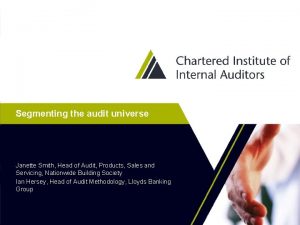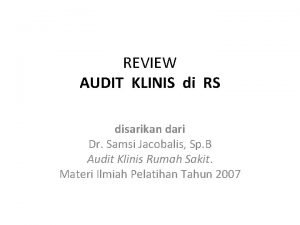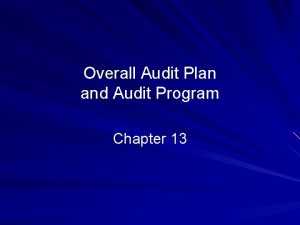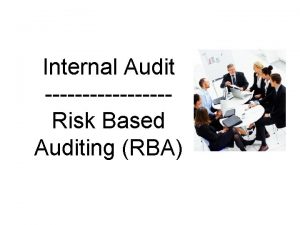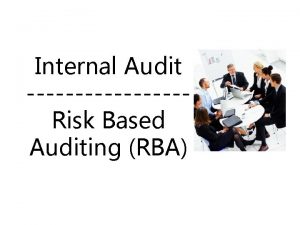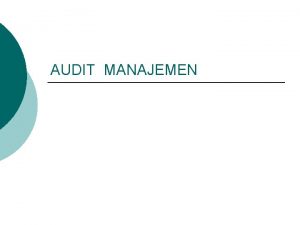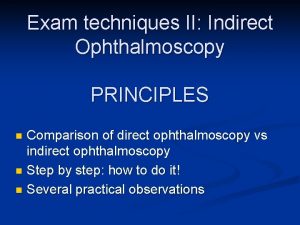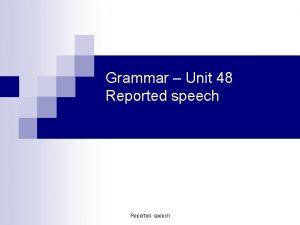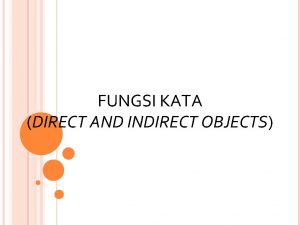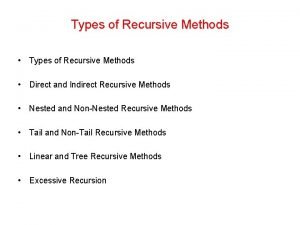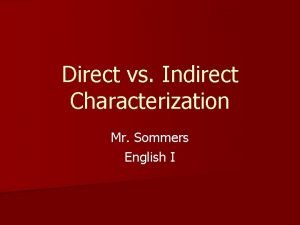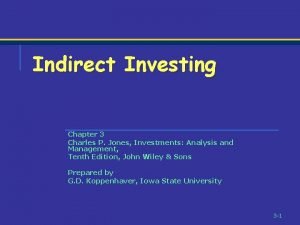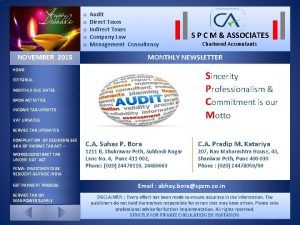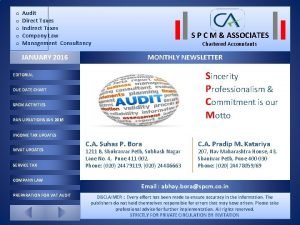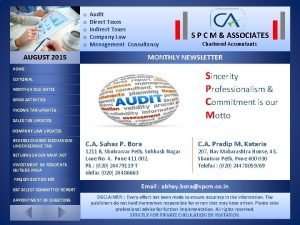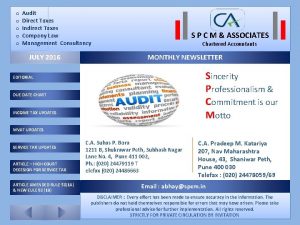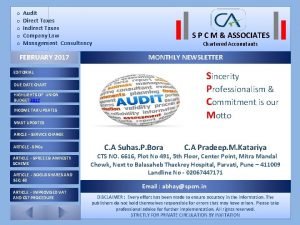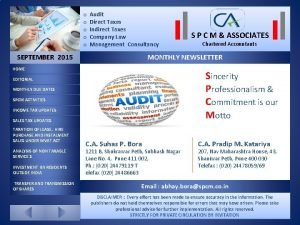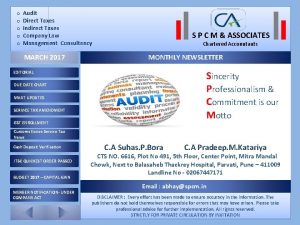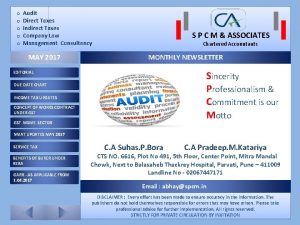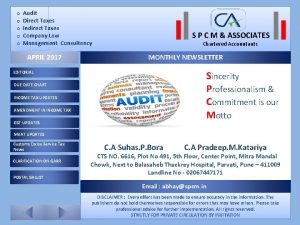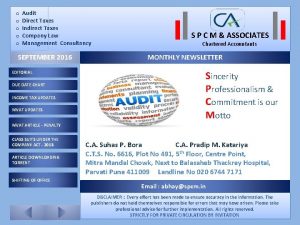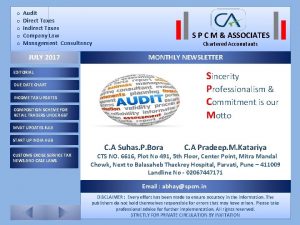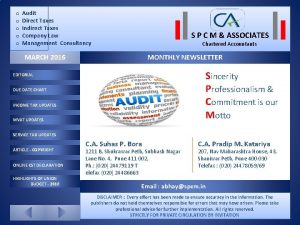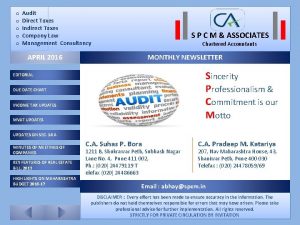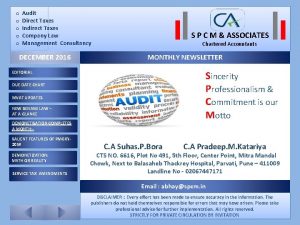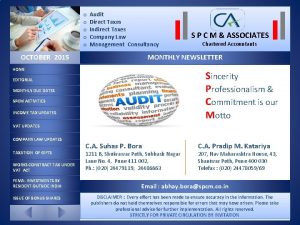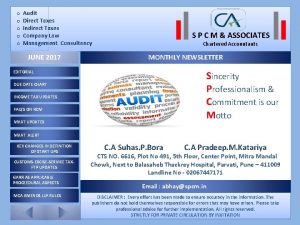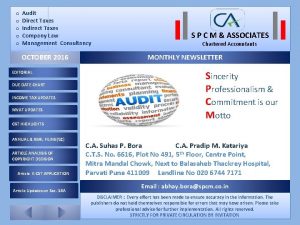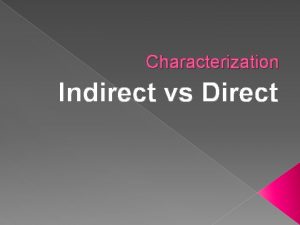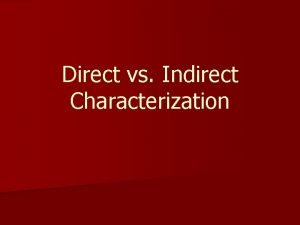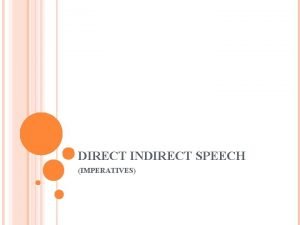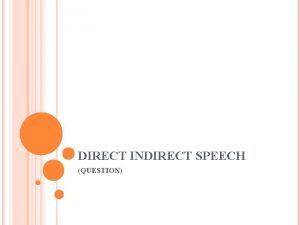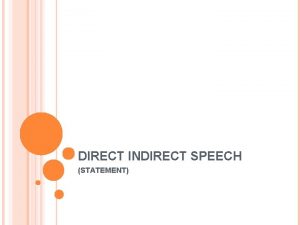o o o Audit Direct Taxes Indirect Taxes



























- Slides: 27

o o o Audit Direct Taxes Indirect Taxes Company Law Management Consultancy S P C M & ASSOCIATES Chartered Accountants MONTHLY NEWSLETTER AUGUST 2016 Sincerity Professionalism & Commitment is our Motto EDITORIAL DUE DATE CHART INCOME TAX UPDATES MVAT UPDATES AMENDMENTS IN COMPANY LAW ARTICLE INTEREST UNDER MVAT ACT ARTICLE ESOP NOTE ARTICLE EXCISE DUTY ON JEWELLERY ARTICLE FAQ ON EXCISE DUTY TO JEWELLERS C. A. Suhas P. Bora 1211 B, Shukrawar Peth, Subhash Nagar Lane No. 4, Pune 411 002, Ph. : (020) 24479119, 24486663 C. A. Pradeep M. Katariya 207, Nav Maharashtra House, 43, Shaniwar Peth, Pune 411 030 Telefax : (020) 24478059/69 Email : abhay@spcm. in DISCLAIMER : Every effort has been made to ensure accuracy in the information. The publishers do not hold themselves responsible for errors that may have arisen. Please take professional advice for further implementation. All rights reserved. STRICTLY FOR PRIVATE CIRCULATION BY INVITATION

AUG. 2016 SPCM & ASSOCIATES MONTHLY NEWSLETTER Editorial - CA. Suhas P. Bora Dear All, The month of July of every year is the busiest month for all the chartered accountants. It is the time when apart from the due dates this of filling of Returns for the Assesse who's books of accounts are not required to be audited U/Sec. 44 AB , attention is required to be given to two important schemes viz. Income Declaration Scheme-2016 and Dispute Resolution Scheme. The expectation from our profession has been manifold and ever increasing. The role of a Chartered Accountants has seen a complete metamorphosis in this century. From being mere bookkeepers, we have now become consultants who advise on complex business strategies. As our role has increased so have the expectations. While, as chartered accountants, we play various roles, our niche area is that of audit. When businesses were small, in a majority of the cases there was complete clarity between the management and the ownership pattern. Consequently, the assurance that was required from the auditor was limited. As businesses became more complex, the number of stakeholders underwent a change. Today, the financial statements authenticated by auditors are relied on by investors from the public, lending banks and financial institutions, regulators and tax gatherers. The expectations of all these stakeholders are different, distinct and at times contradictory. In order to cater to all the different expectations, audits have also been divided into different categories. A statutory audit assures the reader that the financial statements depict a true and fair view, an internal auditor reports on various areas of interest to the management, while a forensic audit seeks to detect fraud where the management or appointing authority suspects one. Unfortunately, neither can these roles be divided into straitjacket compartments, nor is the distinction understood by various stakeholders. This is the challenge that the profession has to meet. One can often sympathize with the auditor as he strives to meet these different and often contradictory expectations. The management expects the financial statements to be drawn up in a manner that the investor is happy to remain invested and the lender is willing to lend. The investor expects that the statements are true and reflect the actual position (and possibly indicate what will happen in future) and expects the auditor to warn him of aberrations, if any. The public expects that the accounts are free from fraud / error and sees the auditor as a whistle blower, while the taxman expects the audited statements and the report thereon to reflect all the data required for computation of income. EDITORIAL DUE DATE CHART INCOME TAX UPDATE MVAT UPDATES AMENDMENTS IN COMPANY LAW INTEREST UNDER MVAT ACT ARTICLE ESOP NOTE EXCISE DUTY ON JEWELLERY FAQ ON EXCISE DUTY TO JEWELLERS

AUG. 2016 SPCM & ASSOCIATES MONTHLY NEWSLETTER Editorial - CA. Suhas P. Bora While the ‘model’ GST Law is out this month, reading the GST law gives a feeling similar to arrival of the incoming flight after a six hour wait at the airport. Just as the pent up anguish and expectancy is settling down, one hears a second announcement. The apologetic voice says that they have found a serious technical snag and are not sure if the flight will ever depart. Bummer! After 15 years of wait, the model GST law gives you that kind of a feeling – is this model law good enough to take off? GST is the largest tax reform attempted by the governance structure, as it is really an economic integration in a federal democracy like ours. While the state laws on taxing goods don’t talk to the central laws on production and services, we can now expect that the Union law will work like one – a union in both letter and spirit. Although it is an massive task to arrive at a consensus, the ‘model’ is nowhere close to being one in every sense of the word. A lot of definitions are picked up from VAT regime and critical definitions lack clarity and completeness. Compliance heavy mechanism of matching invoices will make small traders want to find a ‘way out’ than ‘stay in’. The heart of GST, seamless credit mechanism, is murdered by the condition of actual payment of tax by the seller. Even if a buyer has paid the tax, credit can be denied in case the seller hasn’t deposited that collection. Going back to the airplane analogy, the GST law seems more like a highjack story written by the VAT authorities. In both design and structure, the model law does give a sense of disbelief. Before becoming a Goods and Services Tax, GST needs to meet the test of GOOD and SENSIBLE TAX. A law to be good and sensible at inception is CRITICAL for its success. Success of GST will now depend on the government’s ability to absorb stakeholder comments in the final legislation and the States adopting and enacting the law in its fullest form. I believe, that will truly give us a UNIFIED MARKET and a sense of efficient federal democracy. Stephan Hawking’s wrote, “Intelligence is the ability to adapt to change”. 2. 5 Lac CAs are faced with an incredible opportunity and phenomenal challenge like never before. The greatest risk in a world that is changing at a rapid pace is VANISHING MARKETS. Due to changes in technology some markets that we are used to, could cease to exist. For example, considering BIG DATA, a lot of Audit will happen by matching data from various sources. As CAs we will need to watch this closely and carefully and to keep learning new skills and sharpening those that are still relevant. This could be the singular capability we all will need. I leave you with the words I love – If you have learned how to learn then you have learnt enough. CA. Suhas P. Bora EDITORIAL DUE DATE CHART INCOME TAX UPDATE MVAT UPDATES AMENDMENTS IN COMPANY LAW INTEREST UNDER MVAT ACT ARTICLE ESOP NOTE EXCISE DUTY ON JEWELLERY FAQ ON EXCISE DUTY TO JEWELLERS

SPCM & ASSOCIATES MONTHLY NEWSLETTER AUG. 2016 Due Dates MONTHLY DUE DATES REGISTER FOR AUGUST 2016 ACT SERVICE TAX Particulars E- Payment of Service tax by Companies for July 2016 Due dates 06 th August 2016 INCOME TAX TDS/TCS Payment for the month of July 2016 07 th August 2016 PROVIDENT FUND Provident Fund Payment for the month of July 2016 15 th August 2016 EMPLOYEE STATE INSURANCE CORPORATION Employee State Insurance Corporation Payment for the month of July 2016 21 st August 2016 MVAT/CST E-Payment of Monthly VAT and WCT TDS for July 2016 21 st August 2016 MVAT/CST PROFESSION TAX E-filling of Monthly Returns for July 2016 E-Payment of Monthly Tax for July 2016 21 st August 2016 31 st August 2016 LUXURY TAX E-Payment of Monthly Tax for July 2016 31 st August 2016 NOTE: - If Due date is on Sunday or Public Holidays, the next working day is to be considered as due date. EDITORIAL DUE DATE CHART INCOME TAX UPDATE MVAT UPDATES AMENDMENTS IN COMPANY LAW INTEREST UNDER MVAT ACT ARTICLE ESOP NOTE EXCISE DUTY ON JEWELLERY FAQ ON EXCISE DUTY TO JEWELLERS

SPCM & ASSOCIATES MONTHLY NEWSLETTER AUG. 2016 Income Tax Updates - Deepali R. Shah INCOME TAX UPDATES A. Notification and Circulars 1. CBDT Circular no. 28/2016 dated 27. 07. 2016 on clarification regarding attaining prescribed Age of 60 years/ 80 years on 31 st March itself, in case of Senior/ Very Senior Citizens whose date of birth falls on 1 st April, for purposes of Income-tax Act, 1961 CBDT considered Supreme Court judgement in Prabhu Dayal Sesma vs. State of Rajasthan and in the view of the said judgement CBDT has clarified that person born on 1 st April shall complete his 60 th/80 th birthday on preceding day i. e. 31 st March of earlier year and hence categorized senior/very senior citizen accordingly for tax purposes. 2. CBDT Press Release, dated 22 -7 -2016 - Section 139 A, Read With Section 203 A, Of The Income-Tax Act, 1961 Permanent Account Number -Ease Of Doing Business - Paperless Pan & Tan Application Process For fast tracking the allotment of PAN and TAN to company applicants, Digital Signature Certificate(DSC) based application procedure has been introduced on the portals of PAN service providers M/s NS DL e. Gov and M/s UTIITSL. Under the new process PAN and TAN will be allotted within one day after completion of valid online application. Similarly, a new Aadhaar e-Signature based application process for Individual PAN applicants has been made available on the portals of PAN service providers M/s NSDL e. Gov. 3. CBDT Press Release, dated 22 -7 -2016 -Income Declaration Scheme, 2016 - Relaxation Of Time Schedule For Making Payments Under Said Scheme Various stakeholders have expressed concern that the time period available under the Scheme up to 30 th November, 2016 for making payment of tax, surcharge and penalty is very short, especially where funds in liquid form are not readily available with the declarants. Consideration the practical difficulties of the stakeholders, the Government have decided to revise the time schedule for making payments under the Scheme as under: EDITORIAL DUE DATE CHART INCOME TAX UPDATE MVAT UPDATES AMENDMENTS IN COMPANY LAW INTEREST UNDER MVAT ACT ARTICLE ESOP NOTE EXCISE DUTY ON JEWELLERY FAQ ON EXCISE DUTY TO JEWELLERS

SPCM & ASSOCIATES MONTHLY NEWSLETTER AUG. 2016 Income Tax Updates - Deepali R. Shah (i) a minimum amount of 25% of the tax, surcharge and penalty to be paid by 30. 11. 2016; (ii) a further amount of 25% of the tax, surcharge and penalty to be paid by 31. 3. 2017; and (iii) the balance amount to be paid on or before 30. 9. 2017. A Notification to this effect shall be issued shortly. 4. CBDT Instruction for Compulsory Manual Selection Of Cases For Scrutiny During FY 2016 -2017 The CBDT has issued Instruction No. 4/2016 dated 13 th July 2016 in which it has set out the criteria for compulsory manual selection of cases for scrutiny during the Financial Year 2016 -2017 B. Recent Reported Decisions - High Court and ITAT 1. ACIT vs. Jindal Power Limited (ITAT Raipur) S. 37(1): Expenditure on Corporate Social Responsibility (CSR), though voluntary, is allowable as business expenditure. Explanation 2 to s. 37(1) inserted w. e. f. 01. 04. 2015 is not retrospective. It applies only to CSR expenditure referred to in s. 135 of the Companies Act and not to voluntary CSR expenditure. The amendment in the scheme of Section 37(1), which has been introduced with effect from 1 st April 2015, cannot be construed as to disadvantage to the assessee in the period prior to this amendment. This disabling provision, as set out in Explanation 2 to Section 37(1), refers only to such corporate social responsibility expenses as under Section 135 of the Companies Act, 2013, and, as such, it cannot have any application for the period not covered by this statutory provision which itself came into existence in 2013. Explanation 2 to Section 37(1) is, therefore, inherently incapable of retrospective application any further. 2. R K P Company vs. ITO (ITAT Raipur) S. 40(a)(ia): When there are conflicting judgements of non-jurisdiction High Courts, the Tribunal is not permitted to choose based on its perception of what the correct law is because it will amount to sitting in judgement over the High Courts’ views. Instead, it has to follow the view which is in favour of the assessee even if it believes that this view is not the correct law. Second proviso to s. 40(a)(ia) inserted by FA 2013 should be treated as retrospectively applicable from 1 st April 2005 EDITORIAL DUE DATE CHART INCOME TAX UPDATE MVAT UPDATES AMENDMENTS IN COMPANY LAW INTEREST UNDER MVAT ACT ARTICLE ESOP NOTE EXCISE DUTY ON JEWELLERY FAQ ON EXCISE DUTY TO JEWELLERS

SPCM & ASSOCIATES MONTHLY NEWSLETTER AUG. 2016 Income Tax Updates - Deepali R. Shah It will be wholly inappropriate for us to choose views of one of the High Courts based on our perceptions about reasonableness of the respective view points; as such an exercise will de facto amount to sitting in judgment over the views of the High Courts something diametrically opposed to the very basic principles of hierarchical judicial system. We have to, with our highest respect of both the Hon’ble High Courts, adopt an objective criterion for deciding as to which of the Hon’ble High Court should be followed by us. We find guidance from the judgment of Hon’ble Supreme Court in the matter of CIT vs. Vegetable Products Ltd. [(1972) 88 ITR 192 (SC)]. Hon’ble Supreme Court has laid down a principle that “if two reasonable constructions of taxing provisions are possible, that construction which favours the assessee must be adopted”. This principle has been consistently followed by the various authorities as also by the Hon’ble Supreme Court itself. 3. Urvi Chirag Sheth vs. ITO (ITAT Ahmedabad) S. 56(2)(vii)/ 145 A: Interest awarded on compensation for personal disability does not have the character of "income" and cannot be taxed. CBDT requested to issue instructions to mitigate hardship of accident victims Clearly, unless a receipt is not an income, there is no occasion for the provisions of Section 56(1) or 56(2) coming into play. Section 56 does not decide what an income is. What it holds is that if there is an income, which is not taxable under any of the heads under Section 14, i. e item A to E, it is taxable under the head ‘income from other sources’. The receipt being in the nature of income is a condition precedent for Section 56 coming into play, and not vice versa. To suggest that since an item is listed under section 56(2), even without there being anything to show that it is of income nature, it can be brought to tax is like putting the cart before the horse. The very approach of the authorities below is devoid of legally sustainable merits. The authorities below were thus completely in error in bringing the interest awarded by Hon’ble Supreme Court to tax C. Unreported Decisions 1. ITO vs. Shri Arvind S. Chheda, ITA No. 3421/Mum. /2013, dated 15/06/2016 (Mum. ) (Trib. ) S. 14 A : As the borrowed money was not invested in earning interest income from the firm, provision of Section 14 A cannot be applied. The borrowed money was invested as capital investment in partnership firm from where taxable interest income was earned. The borrowed money was not invested in earning interest income which was claimed as exempt and the assessee is able to establish the direct nexus of the capital investment vis-a-vis earning of taxable income, then the provisions of Section 14 A is not applicable to the assessee. EDITORIAL DUE DATE CHART INCOME TAX UPDATE MVAT UPDATES AMENDMENTS IN COMPANY LAW INTEREST UNDER MVAT ACT ARTICLE ESOP NOTE EXCISE DUTY ON JEWELLERY FAQ ON EXCISE DUTY TO JEWELLERS

SPCM & ASSOCIATES MONTHLY NEWSLETTER AUG. 2016 Income Tax Updates - Deepali R. Shah 2. M/s. Lenient Finvest Pvt. Ltd. vs. ITO, ITA No. 1017/Mum. /2013, dated 22/06/2016 (Mum. ) (Trib. ) S. 271(1)(c) : Penalty – Change of head - Assessee claimed loss from trading in shares as business loss, A. O. treated the same as speculation loss - No penalty for concealment of income The assessee has claimed trading loss on account of purchase and sales of shares as business loss but, the AO treated the same as speculation loss in accordance with Explanation to Section 73 of the Act. The AO initiated penalty proceedings u/s. 271(1)(c) for furnishing of inaccurate particulars of income and levied the same for treating the loss as speculation loss as against the claim of the assessee of business loss. The Hon’ble ITAT had taken view that, merely treating the business loss as speculation loss by the AO does not automatically warrant inference of concealment of income or furnishing of inaccurate particulars of income, particularly when the assessee has furnished full details of purchase and sales of shares. 3. DDIT (E) vs. Maharashtra Samaj Ghatkopar, ITA No. 3654/Mum. /2013, dated 22/06/2016 (Mum. ) (Trib. ) S. 11(1)(a) : Exemption - Set off of deficit is allowable Assessee claimed depreciation and claimed the applicability of Section 11(1)(a) for the purpose of availing exemption. The AO disallowed depreciation and deficit on the ground that the same will amount to “double deduction”. The ITAT held that depreciation of capital asset acquired for the purpose of carrying out charitable activities and set off of deficit of earlier years against the income of current year is allowable. 4. Mr. Moses Dominic Ferreira vs. ITO, ITA No. 3423/Mum. /2013, dated 29/04/2016 (Mum. ) (Trib. ) S. 44 AF rws S. 68 : Cash Credit – Cash and cheques deposited in the bank was on account of sales - Addition restricted to the extent of 5% closing balance of cash and bank Assessee is a trader of building material. During the year assessee deposited cash and cheques in the bank account in respect of sales. Cheques were also issued from bank in respect of materials purchased. Assessee was not able to give substantial details of the deposits in bank account. The AO sustained the addition u/s. 68 on ground that assessee has failed to give proper explanation in regards to the deposits. Held that assessee being a retail trader, he was covered by the provisions of Section 44 AF of the Act. The Hon’ble ITAT held that even if it is presumed that amount of cash and cheques deposited in the bank account was only on account of sales, such cash and cheques deposited in bank along with their opening and closing balance would work out to ` 27, 41, 521/-. Under the provisions of Section 44 AF, the assessee is required to declare profit of 5% on the gross sales, therefore addition made under Section 68 is to be restricted to the extent of 5% of opening and closing balance cash and bank. EDITORIAL DUE DATE CHART INCOME TAX UPDATE MVAT UPDATES AMENDMENTS IN COMPANY LAW INTEREST UNDER MVAT ACT ARTICLE ESOP NOTE EXCISE DUTY ON JEWELLERY FAQ ON EXCISE DUTY TO JEWELLERS

SPCM & ASSOCIATES MONTHLY NEWSLETTER AUG. 2016 MVAT Updates - CA GOURAV OSWAL, CA NIKITA BAJAJ MVAT UPDATES -CA GOURAV OSWAL, CA NIKITA BAJAJ RECENT AMENDMENTS Trade Circular No 19 T of 2016 Dt. 30. 06. 2016 The Commissioner of Sales Tax, Maharashtra State, Mumbai has issued Trade Circular No. 19 T of 2016, dt. 30. 06. 2016. The circular contains various FAQ`s and their answers for bringing clarity to various points and issues raised by the Trade and Associations in the Maharashtra Settlement of Arrears in Dispute Act, 2016. Trade Circular No 20 T of 2016 Dt. 19. 07. 2016 The Commissioner of Sales Tax, Maharashtra State, Mumbai has issued Trade Circular No. 20 T of 2016, dt. 19. 07. 2016. The circular contains various FAQ`s and their answers for bringing further clarity to various points and issues raised by the Trade and Associations in the Maharashtra Settlement of Arrears in Dispute Act, 2016. All the previous FAQ`s and their answers have been clubbed in this circular. EDITORIAL DUE DATE CHART INCOME TAX UPDATE MVAT UPDATES AMENDMENTS IN COMPANY LAW INTEREST UNDER MVAT ACT ARTICLE ESOP NOTE EXCISE DUTY ON JEWELLERY FAQ ON EXCISE DUTY TO JEWELLERS

SPCM & ASSOCIATES MONTHLY NEWSLETTER AUG. 2016 MVAT Updates - CA GOURAV OSWAL, CA NIKITA BAJAJ INFORMATION UPDATES ON WEBSITE OF SALES TAX DEPARTMENT Following updates have been made available in whats new section of website of Sales Tax Department i. e www. mahavat. gov. in a. b. c. d. e. f. g. EDITORIAL User Manual for uploading Form I under Amnesty Scheme 2016 FAQ on Profession Tax Amnesty Scheme Help desk list for Settlement of Dispute Arrears Act New Return filing template Updated list of non-genuine dealer as on July 2016 List of dealers registered under various acts from 25. 05. 2016 to 23. 07. 2016 Draft model and overview of Goods and Service Tax Law DUE DATE CHART INCOME TAX UPDATE MVAT UPDATES AMENDMENTS IN COMPANY LAW INTEREST UNDER MVAT ACT ARTICLE ESOP NOTE EXCISE DUTY ON JEWELLERY FAQ ON EXCISE DUTY TO JEWELLERS

SPCM & ASSOCIATES MONTHLY NEWSLETTER AUG. 2016 AMENDMENT UNDER COMPANY LAW – CA MANOJ JAIN , CS ADITI JOSHI AMENDMENTS UNDER COMPANY LAW CA MANOJ JAIN, CS ADITI JOSHI GIST OF RECENT CHANGES IN COMPANY LAW DATED 1 ST JULY 2016 A. DEPOSITS: The time limit for compulsory convertible debentures increased from 5 years to 10 years. Non – convertible unsecured Debentures are not deposits if listed on Stock Exchanges. The amount received as a part of warranty/ maintenance scheme then the time limit of 365 days would be extended to 5 years or normally accepted period in industry whichever is low. For – start up India – an amount received for convertible note will not be treated as deposits. Amount received as collective investment scheme approved by SEBI is not a deposit. Any amount received from a Registered Venture Capital Fund is not a deposit. Any Company can accept deposits upto 35% (instead of 25%) of paid up Capital and Free reserves from its members; in case of private limited company the limit is 100%. The exemption from deposit Insurance extended upto 31. 03. 2017. Advertisement for Deposits is also required to be placed on the website of the Company. Every Company in their Financial Statements must disclose the amount received from Directors as unsecured Loan and every Private Company shall additionally disclose the amount received from the relatives of the directors. EDITORIAL DUE DATE CHART INCOME TAX UPDATE MVAT UPDATES AMENDMENTS IN COMPANY LAW INTEREST UNDER MVAT ACT ARTICLE ESOP NOTE EXCISE DUTY ON JEWELLERY FAQ ON EXCISE DUTY TO JEWELLERS

SPCM & ASSOCIATES MONTHLY NEWSLETTER AUG. 2016 AMENDMENT UNDER COMPANY LAW – CA MANOJ JAIN , CS ADITI JOSHI B. KEY MANAGEMENT PERSONEL: The form MR-1 need not be filled for CEO, CFO and the Company Secretary. C. DISCLOSURE ABOUT EMPLOYEES: The Directors Report shall disclose the details of top 10 Employees only & only if the amount of salary paid to them is more than Rs. 8, 50, 000/- per month or Rs. 1, 02, 000/- per annum as the case may be. D. AUDITORS: The rotation of auditors was required to be complied within 3 years from the commencement of the Act. Now the difficulty has been removed and the same can be done at the AGM held after 31 st March 2017. EDITORIAL DUE DATE CHART INCOME TAX UPDATE MVAT UPDATES AMENDMENTS IN COMPANY LAW INTEREST UNDER MVAT ACT ARTICLE ESOP NOTE EXCISE DUTY ON JEWELLERY FAQ ON EXCISE DUTY TO JEWELLERS

SPCM & ASSOCIATES MONTHLY NEWSLETTER AUG. 2016 PROVISIONS OF INTEREST UNDER MVAT ACT, 2002 - Adv. Abhay Bora 1. INTEREST PAYABLE BY A DEALER OR PERSON (SECTION 30) (A) Section 30(1) – Late payment of tax by Unregistered Dealers or Dealers who have failed to apply for registration in time. • Failure to apply for Registration in time. • The dealer is liable to pay interest from 1 st April of respective year to the date of payment of tax. • If part payment is made, then the same is required to be taken into consideration while calculating interest for the same. • The interest levied is required to be modified if tax liability increases or decreases as per any order under the MVAT Act, 2002. • Quantum of such interest shall not exceed the quantum of tax found payable for the respective year. (B) Section 30(2) – Late payment of tax by Registered Dealers. • Failure to make payment of tax in time by Registered Dealer. • The interest becomes due after the due date of filing the return. • If part payment is made, then the same is required to be taken into consideration while calculating interest for the same. • In the case of filing a fresh return or a revised return, the dealer is required to pay interest from the due date of the original return on the additional amount of tax required to be paid at the time of filing of a fresh return or revised return. • In case an annual revised return is filed under clause (b) or clause (c) of sub-section (4) of section 20, then interest shall be payable on excess amount of tax as per the annual revised return from 1 st October of the year to which the annual revised return relates till the date of payment of excess amount of tax. However if certificate of registration is granted/cancelled effective from any date after/prior to 30 th September respectively of the year to which the revised return relates then interest needs to be computed from effective date of registration/cancellation respectively. EDITORIAL DUE DATE CHART INCOME TAX UPDATE MVAT UPDATES AMENDMENTS IN COMPANY LAW INTEREST UNDER MVAT ACT ARTICLE ESOP NOTE EXCISE DUTY ON JEWELLERY FAQ ON EXCISE DUTY TO JEWELLERS

SPCM & ASSOCIATES MONTHLY NEWSLETTER AUG. 2016 PROVISIONS OF INTEREST UNDER MVAT ACT, 2002 - Adv. Abhay Bora (C) Section 30(3) – Interest on differential dues, on assessment. Ø Failure to make payment of tax in time by Registered Dealer other than tax on which interest U/sec. 30(2) is payable. Ø Interest is applicable if such tax remains unpaid for period of one month from the date of assessment. Ø The interest under this sub-section is payable from the next date following the last date of the period covered by an order of assessment till the date of order of assessment. Ø If part payment is made, then the same is required to be taken into consideration while calculating interest for the same. Ø The interest levied is required to be modified if tax liability increases or decreases as per any order under the MVAT Act, 2002. Where the tax liability is enhanced, the interest on the enhanced amount shall be calculated upto the date of such order. Rate of Interest as per Rule 88(1) to be paid under Sec 30(1), 30(2) and 30(3) The rate of interest was 1. 25% per month from 01. 04. 2005 till 01. 12. 2015. The revised rates of interest prescribed under rule 88(1) from 01. 12. 2015 for the purpose of sub-section 1, 2 and 3 of section 30 of MVAT Act 2002 are as follows: EDITORIAL Sr. No. Period of delay Rate of Interest 1) Upto 1 month One and a quarter percent of the amount of such tax, for the month or part thereof 2) Upto 3 months One and a quarter percent of the amount of such tax, for the month or part thereof for the first month of delay and One and a half percent of the amount of such tax, for each month or part thereof for delay beyond 1 month upto 3 months 3) Beyond 3 months One and a quarter percent of the amount of such tax, for the month or part thereof for the first month of delay and One and a half percent of the amount of such tax, for each month or part thereof for delay beyond 1 month upto 3 months and two percent of the amount of such tax, for each month or part thereof for the period of delay beyond 3 months DUE DATE CHART INCOME TAX UPDATE MVAT UPDATES AMENDMENTS IN COMPANY LAW INTEREST UNDER MVAT ACT ARTICLE ESOP NOTE EXCISE DUTY ON JEWELLERY FAQ ON EXCISE DUTY TO JEWELLERS

SPCM & ASSOCIATES MONTHLY NEWSLETTER AUG. 2016 PROVISIONS OF INTEREST UNDER MVAT ACT, 2002 - Adv. Abhay Bora The old rates of interest will apply where default starts and ends before 1 st December 2015 i. e if the tax becomes due before 1 st December 2015 and the default continues after 1 st December 2015, then for the period of default before 1 st December 2015 the old rates of interest shall apply and in so far as default continues after 1 st December 2015 the new rates will apply. (D) Section 30(4) – Interest on revised return filed in specific circumstances This interest is payable by a dealer when he files one or more revised return in consequence of any intimation issued under sub-section 7 of section 63 or after the commencement of : Audit of the business of the dealer in respect of any period Inspection of accounts, registers and documents pertaining to any period, kept at any place of business of the dealer Entry and search of any place of business or any other place where the dealer has kept his accounts, registers, documents pertaining to any period or stock of goods Interest is payable @ 25% of additional tax payable as per the return or revised return. However if the amount of tax paid as per the revised return is less than 10% of the aggregrate amount of tax paid as per the original returns in respect of corresponding period, then no interest under this sub-section shall be payable. Interest under this sub-section shall not be payable on account of additional tax liability arising due to non-production of declarations or certificates. 2. INTEREST RECEIVABLE BY THE REGISTERED DEALER/PERSON U/S 52 AND 53 R. W. RULE 88 Section 52 – Interest on Refund This refund is available to a registered dealer It is payable when refund becomes due Interest is available for the period commencing on the date next following the last date of the period to which the refund relates and ending on the date of the order sanctioning the refund or, for a period of 24 months; whichever is less. The interest is to be calculated after deducting the amount of penalty, sum forfeited and interest charged, if any, and any amount adjusted under the Act or earlier law or under the CST Act. . EDITORIAL DUE DATE CHART INCOME TAX MVAT UPDATES AMENDMENTS IN COMPANY INTEREST UNDER ARTICLE ESOP NOTE EXCISE DUTY ON FAQ ON EXCISE DUTY TO

SPCM & ASSOCIATES MONTHLY NEWSLETTER AUG. 2016 PROVISIONS OF INTEREST UNDER MVAT ACT, 2002 - Adv. Abhay Bora If, as a result of any order passed under the MVAT Act, 2002, the amount of refund increases or decreases, then the interest shall be modified accordingly. Excess refund granted shall be recovered as if it is an amount payable under the Act. Interest under this section shall not be granted towards the refund granted u/s. 51. Where the refund of tax is arising out of payment of tax which is made after the last date prescribed for such payment, then interest shall be calculated for that period from the date of such payment to the date of such order. Rate of interest : ½ per cent of the amount of such tax for each month or part thereof. Section 53 – Interest on delayed refund If the amount is not refunded within 90 days, then person is entitled to receive this interest. Interest is to be calculated from the date immediately following the expiry of the period of 90 days to the date of the refund. Where the amount becomes refundable due to an order of Tribunal, High Court or the Supreme Court, the interest shall be calculated after 90 days from the date of receipt of such order by the officer. If the applicant dealer/person supplies the copy of such order, then the date is to be calculated after 90 days from such supply. If the delay in granting refund within 90 days is attributable to the claimant, then such delay, whether wholly or in part, shall be excluded from the period for which interest is payable. The decision of the Commissioner shall be final on the issue of exclusion of days. Rate of interest: ½ per cent of the amount of such tax for each month or part thereof. EDITORIAL DUE DATE CHART INCOME TAX MVAT UPDATES AMENDMENTS IN COMPANY INTEREST UNDER ARTICLE ESOP NOTE EXCISE DUTY ON FAQ ON EXCISE DUTY TO

SPCM & ASSOCIATES MONTHLY NEWSLETTER AUG. 2016 ESOP - A ‘Sense of Ownership’ for the employees -CA Manoj Jain, CS Aditi Joshi ESOP - A ‘Sense of Ownership’ for the employees When the employees are given shares of the same company in which they are working, it gives them a sense of feeling that now they are not employees of this organization but are the owners. As they are now they owners, they also have a share in the profits of the company. In fact, since employees directly benefit from the increase in the share price, they focus on overall value creation for the company. ESOP’s are Employee Stock Option Plans under which employees receive the right to purchase a certain number of shares in the company at a predetermined price, as a reward for their performance and also as motivation for employees to keep increasing their performance. Employees typically have to wait for a certain duration known as vesting period before they can exercise the right to purchase the shares. The main aim of giving such a plan to its employees is to give shares of the company to its employees at a discounted price to the market price at the time of exercise. Many companies (especially in the startup phase) have now started giving Employee Stock Options as this is beneficial to both the employer as well as the employee. A company having share capital propose to increase its subscribed share capital by issue of further shares, such shares may be offered to employees under a scheme of employees’ stock options through special resolution passed by company and subject to such conditions as may be prescribed. A company, other than a listed company which is not required to comply with Securities and Exchange Board of India Employee Stock Option Scheme Guidelines shall not offer shares to its employees under a scheme of employees’ stock option (hereinafter referred to as “Employees Stock Option Scheme”), unless it complies with Rule 12 of the Companies (Share Capital and Debentures) Rules 2014. ‘‘Employee’’ means and includes (a) A permanent employee of the company who has been working in India or outside India; or (b) A director of the company, whether a whole time director or not but excluding an independent director; or (c) An employee as defined in clauses (a) or (b) of a subsidiary, in India or outside India, or of a holding company of the company or of an associate company. But does not include. An employee who is a promoter or a person belonging to the promoter group; or A director who either himself or through his relative or through any body-corporate, directly or indirectly, holds more than ten percent of the outstanding equity shares of the company. EDITORIAL DUE DATE CHART INCOME TAX UPDATE MVAT UPDATES AMENDMENTS IN COMPANY LAW INTEREST UNDER MVAT ACT ARTICLE ESOP NOTE EXCISE DUTY ON JEWELLERY FAQ ON EXCISE DUTY TO JEWELLERS

SPCM & ASSOCIATES MONTHLY NEWSLETTER AUG. 2016 ESOP - A ‘Sense of Ownership’ for the employees -CA Manoj Jain, CS Aditi Joshi Exercise Price: The companies granting option to its employees pursuant to Employees Stock Option Scheme will have the freedom to determine the exercise price in conformity with the applicable accounting policies, if any. Special Approvals: The approval of shareholders by way of separate resolution shall be obtained by the company in case of Grant of option to employees of subsidiary or holding company; or Grant of option to identified employees, during any one year, equal to or exceeding one percent of the issued capital (excluding outstanding warrants and conversions) of the company at the time of grant of option. Variation in Terms of ESOP: The company may by special resolution, vary the terms of Employees Stock Option Scheme not yet exercised by the employees provided such variation is not prejudicial to the interests of the option holders. The notice for passing special resolution for variation of terms of Employees Stock Option Scheme shall disclose full of the variation, the rationale therefore, and the details of the employees who are beneficiaries of such variation. Vesting of Option: There shall be a minimum period of one year between the grant of options and vesting of option: In a case where options are granted by a company under its Employees Stock Option Scheme in lieu of options held by the same person under an Employees Stock Option Scheme in another company, which has merged or amalgamated with the first mentioned company, the period during which the options granted by the merging or amalgamating company were held by him shall be adjusted against the minimum vesting period required under this clause. The company shall have the freedom to specify the lock-in period for the shares issued pursuant to exercise of option. The Employees shall not have right to receive any dividend or to vote or in any manner enjoy the benefits of a shareholder in respect of option granted to them, till shares are issued on exercise of option. Forfeiture or Refund: The amount, if any, payable by the employees, at the time of grant of option may be forfeited by the company if the option is not exercised by the employees within the exercise period; or the amount may be refunded to the employees if the options are not vested due to non-fulfillment of conditions relating to vesting of option as per the Employees Stock Option Scheme. EDITORIAL DUE DATE CHART INCOME TAX UPDATE MVAT UPDATES AMENDMENTS IN COMPANY LAW INTEREST UNDER MVAT ACT ARTICLE ESOP NOTE EXCISE DUTY ON JEWELLERY FAQ ON EXCISE DUTY TO JEWELLERS

SPCM & ASSOCIATES MONTHLY NEWSLETTER AUG. 2016 ESOP - A ‘Sense of Ownership’ for the employees -CA Manoj Jain, CS Aditi Joshi Transferability: The option granted to employees shall not be transferable to any other person. The option granted to the employees shall not be pledged, hypothecated, mortgaged or otherwise encumbered or alienated in any other manner. No person other than the employees to whom the option is granted shall be entitled to exercise the option. In the event of the death of employee while in employment, all the options granted to him till such date shall vest in the legal heirs or nominees of the deceased employee. In case the employee suffers a permanent incapacity while in employment, all the options granted to him as on the date of permanent incapacitation, shall vest in him on that day. In the event of resignation or termination of employment, all options not vested in the employee as on that day shall expire. However, the employee can exercise the options granted to him which are vested within the period specified in this behalf, subject to the terms and conditions under the scheme granting such options as approved by the Board. Disclosure in Director Report: The Board of directors, shall, inter alia, disclose in the Directors’ Report for the year all the details of the Employees Stock Option Scheme such as Options granted; options vested; options exercised; the total number of shares arising as a result of exercise of option; options lapsed; the exercise price; variation of terms of options; money realized by exercise of options; total number of options in force; employee wise details of options granted to; - Key managerial personnel; Any other employee who receives a grant of options in any one year of option amounting to five percent or more of optionsgranted during that year; Identified employees who were granted option, during any one year, equal to or exceeding one percent of the issued capital (excluding outstanding warrants and conversions) of the company at the time of grant. Benefits of ESOP’s : The major benefits of awarding Employee Stock Options are mentioned below: Lock-in Period: ESOP’s come with a lock-in period known as vesting period and employees can exercise the options only after this period. If the employee leaves the organization before completing the specified period – these ESOP’s get lapsed and the employee will not get any benefit. Kind instead of Cash ESOP’s are a way of awarding the employees in kind instead of cash. In the initial days of ESOP’s in India, small organizations who were cash strapped used to give ESOP’s to their employees to increase the overall pay package. In this manner, they were able to compensate the employees in kind without affecting their cash reserves (if an organization issues ESOP’s- its cash reserves are not affected). “GIVING BENEFITS WILL RESULT IN HAVING BENEFITS. ” EDITORIAL DUE DATE CHART INCOME TAX UPDATE MVAT UPDATES AMENDMENTS IN COMPANY LAW INTEREST UNDER MVAT ACT ARTICLE ESOP NOTE EXCISE DUTY ON JEWELLERY FAQ ON EXCISE DUTY TO JEWELLERS

SPCM & ASSOCIATES MONTHLY NEWSLETTER AUG. 2016 INTRODUCTION TO CENTRAL EXCISE ON JEWELLERY -Adv. Sanket S. Bora Central Excise duty on Jewellery though introduced initially for branded Jewellery and later extended to all Jewellery items was subsequently withdrawn due to pressure from the industry. However as Budget 2016 tax proposals, changes were made w. e. f. 1 st. March 2016, by withdrawing exemptions given earlier thereby extending the tax base of Central Excise to Jewellery sector as well w. e. f. 01. 03. 2016. The scheme of levy and collection of Central Excise duty on articles of Jewellery is as under: a. A The levy and collection of Central Excise Duty is on the manufacture of Jewellery (excluding silver Jewellery, not studded with diamonds, ruby, emerald or sapphire). b. It is applicable to both branded as well as unbranded Jewellery. c. The rate of duty on the Jewellery are as follows: i. 1% on transaction value [without Cenvat credit on inputs and capital goods. However proportionate credit on input services is eligible] or ii. 12. 5% with Cenvat credit of inputs, input services and capital goods. d. The benefit of SSI exemption (exemption based on value of clearance) is available if the value of manufactured goods (on own or through job worker) cleared domestically has not crossed Rs. 15 Crores (all goods manufactured including silver Jewellery) in the financial year 2014 -15. The benefit for March 2016 is 85 lakhs. e. Similarly if the domestic value of clearance has not crossed 15 (all goods manufactured including silver Jewellery) crores in the financial year 2015 -16, for the financial year 2016 -17, exemption upto 10 crores of value of clearances can be availed. f. The said exemption based on value of clearance is not available if manufacturer affixes the brand name of another person. EDITORIAL DUE DATE CHART INCOME TAX UPDATE MVAT UPDATES AMENDMENTS IN COMPANY LAW INTEREST UNDER MVAT ACT ARTICLE ESOP NOTE EXCISE DUTY ON JEWELLERY FAQ ON EXCISE DUTY TO JEWELLERS

SPCM & ASSOCIATES MONTHLY NEWSLETTER AUG. 2016 INTRODUCTION TO CENTRAL EXCISE ON JEWELLERY -Adv. Sanket S. Bora g. For determining the eligibility for availing SSI exemption based on previous financial year as explained above, a certificate from a chartered accountant, based on books of account shall suffice and does not require any verification from the departmental officers’ side. h. While computing the above said value of clearances, the value of Exports or the value of traded goods i. e. purchased and sold or the goods manufactured with the brand name of others (on which duty has to be paid) should not be counted. Further, the CBEC has issued a press release dated 13 -7 -2016 accepting the recommendations of the Sub-Committee apropos compliance procedure for excise duty, records to be maintained and other relevant administrative issues. The following are the pointers covering the press release: • Ground Plan of the premises not required for registration • Excise duty is payable at first sale invoice value • Incase invoice does not show excise duty separately, the value for VAT will be treated as cum duty value [value + excise duty] • No Excise duty on traded goods • Records maintained for State VAT and other private records, showing details of inputs, stocks, manufactured goods, sold/exported goods, etc. will be accepted for excise purpose • Stock details to be maintained on weight and caratage basis • Movement of jewellery, which does not involve sale may not be liable to excise duty. Example: movement of jewellery, to be shown as samples, branch transfers not involving sale, for display in exhibition, for hallmarking, and for approval before sale • There won’t be any transit checks by excise officers • When a retail customer brings jewellery [other than in form of gold or any precious metal] to a jeweller which is converted into new jewellery by the jeweller or a job worker of such jeweller, excise duty will be payable only on value addition, including cost of additional materials and labour charges charged, subject to the maintenance of certain records. EDITORIAL DUE DATE CHART INCOME TAX UPDATE MVAT UPDATES AMENDMENTS IN COMPANY LAW INTEREST UNDER MVAT ACT ARTICLE ESOP NOTE EXCISE DUTY ON JEWELLERY FAQ ON EXCISE DUTY TO JEWELLERS

SPCM & ASSOCIATES MONTHLY NEWSLETTER AUG. 2016 • • • INTRODUCTION TO CENTRAL EXCISE ON JEWELLERY -Adv. Sanket S. Bora Repairs and alterations, which do not change the identity, character and use of the goods and do not result in a new item is not “manufacturing” and may not attract excise duty An optional scheme may be prescribed for jewellers who are not able to maintain separate physical stocks and / or records of manufactured and traded goods Excise audit may not be be carried out, for the first two years, for units whose duty payment (cash plus credit) is less than Rs. 1 crore, [that is turnover of manufactured goods less than Rs. 100 crore. ] The wouldn’t be any visit, search and seizure at job workers premises There wouldn’t be any visit to premises of the principal manufacturer [jeweller], except on the basis of specific intelligence and with the approval of Commissioner or equivalent rank officer Summons may be issued only with the approval of Commissioner NOTE: CBEC has issued the following notifications and circulars apropos to excise on jewellery on 26 -07 -2016: Not. 26 -29 CE, dt. 26 -07 -2016, Not. 33 -40 CE(NT)dt. 26 -07 -2016 Circ. 1040 -1045/28 -33/2016 dt. 26 -07 -2016 EDITORIAL DUE DATE CHART INCOME TAX UPDATE MVAT UPDATES AMENDMENTS IN COMPANY LAW INTEREST UNDER MVAT ACT ARTICLE ESOP NOTE EXCISE DUTY ON JEWELLERY FAQ ON EXCISE DUTY TO JEWELLERS

SPCM & ASSOCIATES MONTHLY NEWSLETTER AUG. 2016 FAQ’s On Central Excise Registration Procedure For Jewellers - Adv. Sanket S. Bora FAQ’s on CENTRAL EXCISE REGISTRATION PROCEDURE FOR JEWELLERS -Adv. Sanket S. Bora 1. What is manufacture in the context of Jewellery products? The term ‘manufacture’ in general for Central Excise Purposes is understood to be any process whereby the goods processed would change as to name, character or use as is known in the market. Hence, to consider whether levy of Central Excise Duty is attracted, one has to satisfy the following four conditions: a. There should be Manufacture; b. Manufacture should be of Goods (Movable and Marketable); c. Such goods manufactured should be Excisable Goods (set out in I or II Schedule to Central Excise Tariff Act, 1985 as subject to Duty); d. Manufacture should happen in India. Therefore, the term ‘manufacture’ is understood to be any process whereby the goods processed would change as to name, character or use as is known in the market. The same is equally applicable even for Jewellery products as well. In addition to this there is a concept of deemed manufacture wherein certain processes are deemed to be manufacture even though it is not considered as manufacture in the common understanding as explained above. In the context of Jewellery articles in addition to normal understanding of manufacture, the processes of affixing or embossing trade name or brand name on articles of Jewellery or on articles of goldsmiths' or silversmiths' wares of precious metal or of metal clad with precious metal is deemed to be "manufacture". 2 What is the meaning of the term ‘job worker’? Job worker has been defined under Rule 12 AA of the Central Excise Rules as follows: a. Any person engaged on manufacturing or processing; b. On behalf of and under instruction of person getting the goods manufactured (said person); c. On any inputs supplied by said person or any person authorised by said person; So as to complete a part or whole of the process resulting ultimately in manufacture of articles of Jewellery falling under heading 7113. EDITORIAL DUE DATE CHART INCOME TAX UPDATE MVAT UPDATES AMENDMENTS IN COMPANY LAW INTEREST UNDER MVAT ACT ARTICLE ESOP NOTE EXCISE DUTY ON JEWELLERY FAQ ON EXCISE DUTY TO JEWELLERS

SPCM & ASSOCIATES MONTHLY NEWSLETTER AUG. 2016 FAQ’s On Central Excise Registration Procedure For Jewellers - Adv. Sanket S. Bora 3 What is the definition of Factory in the context of Jewellers? Factory is defined as any premise, including precincts thereof, wherein or in any part of which excisable goods are manufactured. It also includes any other place where any process connected with the production of these goods is carried on or ordinarily carried on. Usually jewellery is manufactured in the workshop of the jeweler and hence the workshop may be considered as factory for the purpose of excise. Further, if any incidental process is carried out in the showroom, then it shall also be considered as a factory. 4 When registration to be obtained? Registration needs to be obtained within 30 days from the date when liability to pay duty arises. Hence, the registration needs to be taken till 30 th march, 2016 as the liability arose w. e. f. 1. 3. 2016. As per Circular No. 1033/21/2016 -CX the time limit for taking Central Excise Registration is extended up to 31 -7 -2016. 5 Which premises has to be registered? Assessment under Central Excise is factory based. Whichever premise satisfying the definition of factory is required to get registration unless specifically exempted. If the jeweler is operating from more than one factory, separate registration certificate shall be obtained for each of such factories. However, for Jewellery Sector a special provision is been passed wherein centralized registration is permitted [Notification No. 5/2016 - Central Excise (N. T. ) dated 1 -3 -2016] 6 When Jewellery is manufactured in workshop but affixing brand name is done in showroom, then which premise will be considered factory? The workshop is a factory as the manufacturing process is carried down in the workshop. Further, the process of affixing brand name or trade name is deemed manufacturing, therefore the showroom shall also be considered as factory for the purpose of excise. EDITORIAL DUE DATE CHART INCOME TAX UPDATE MVAT UPDATES AMENDMENTS IN COMPANY LAW INTEREST UNDER MVAT ACT ARTICLE ESOP NOTE EXCISE DUTY ON JEWELLERY FAQ ON EXCISE DUTY TO JEWELLERS

SPCM & ASSOCIATES MONTHLY NEWSLETTER AUG. 2016 FAQ’s On Central Excise Registration Procedure For Jewellers - Adv. Sanket S. Bora 7 When a jeweller is getting goods manufactured through different job worker and does not have any of his manufacturing unit or factory, then which premise is to be registered? In case of Jewellery Sector, Rule 12 AA of the Central Excise Rules, 2004 provides that every person getting the articles of Jewellery and/or other articles of precious metals manufactured on his behalf on job work basis shall obtain registration. Hence in such a scenario the job worker need not register and the principal manufacturer shall require registering his showroom or any other premise from where the jeweler carries out his business. 8 When is centralised registration permitted? Usually separate registration is to be taken for separate factories but for Jewellery Sector, a provision for centralized registration is made for jewelers having multiple manufacturing units. The Jewellery Sector is exempted from Rule 9(2) of the Central Excise Rules, 2004 and allowed centralized registration to the jeweler, where the manufactured goods have a centralized billing or accounting system in respect of such goods manufactured or produced by different factories or premises and opts for registering only the factory or premises or office, from where such centralised billing or accounting is done and where the accounts/records showing receipts of raw materials and finished excisable goods manufactured or received back from job workers are kept. [Notification No. 5/2016 - Central Excise (N. T. ) dated 1 -3 -2016] 9 Whether details of all the premises (including job work) needs to be given in the registration application? Manufacturer opting for centralised registration is required to give details of all the premises where manufacturing activities are carried out. However, details of job worker premise are not required to be given. 10 Is it possible to show workshops as job work unit so as not to disclose in the registration certificate? Yes, each of the workshops may be considered as job work unit. If considered so, there is no need to give details of all such workshops in the registration application. EDITORIAL DUE DATE CHART INCOME TAX UPDATE MVAT UPDATES AMENDMENTS IN COMPANY LAW INTEREST UNDER MVAT ACT ARTICLE ESOP NOTE EXCISE DUTY ON JEWELLERY FAQ ON EXCISE DUTY TO JEWELLERS

SPCM & ASSOCIATES MONTHLY NEWSLETTER AUG. 2016 FAQ’s On Central Excise Registration Procedure For Jewellers - Adv. Sanket S. Bora 11 Is it compulsory to obtain centralised registration? No, it is not necessary to obtain centralised registration. It is a facility not compulsion. Manufacturer may obtain separate registration for each of his workshops (factories) instead of obtaining centralised registration. 12 Which option is better; centralised registration or separate registration? It depends upon the business model being followed by manufacturer. In general, it could be suggested to make one of the workshops at nodal workshop where all the records are maintained. This could waive the requirement to take registration at showroom which may be used exclusively for trading of goods received from workshops along with goods purchased from other for trading purpose. Furthermore, the showroom may be registered as Input Service Distributor to distribute the credits on input services to workshops. This credit may be utilized by workshops to utilize against their liability arising on removal of goods under both the options (1% or 12. 5%). 13 What is process to take registration? Application for registration shall be filed only online on the website www. aces. gov. in. Necessary documents are required to be submitted physically in support of the details furnished in the registration application. 14 Whetherpremises of manufacturer are physically visited before granting registration? It is provided in Notification No. 35/2001 -CE (NT) that authorized officer shall verify the premises physically within seven days from the date of receipt of application through online. But there is special provision to provide that the officer shall not visit the factory or premises of the person engaged in the manufacture or production of articles of Jewellery. Therefore, there will not be any physical verification neither before nor after obtaining registration. 15 What is the time limit for granting registration? The registration has to be granted within 7 days of receipt of duly completed application. It is guided that in case of Jewellery assessee, registration is to be given within 2 working days. EDITORIAL DUE DATE CHART INCOME TAX UPDATE MVAT UPDATES AMENDMENTS IN COMPANY LAW INTEREST UNDER MVAT ACT ARTICLE ESOP NOTE EXCISE DUTY ON JEWELLERY FAQ ON EXCISE DUTY TO JEWELLERS

S P C M & ASSOCIATES Chartered Accountants Thank You
 Prosedur audit bottom-up dan audit top-down
Prosedur audit bottom-up dan audit top-down Audit universe definition
Audit universe definition Beda audit medis dan audit klinis
Beda audit medis dan audit klinis Vouching
Vouching Overall audit plan and audit program
Overall audit plan and audit program Penyelesaian audit dan tanggung jawab pasca audit
Penyelesaian audit dan tanggung jawab pasca audit Perbedaan audit konvensional dengan audit berbasis risiko
Perbedaan audit konvensional dengan audit berbasis risiko Perbedaan audit konvensional dengan audit berbasis risiko
Perbedaan audit konvensional dengan audit berbasis risiko Hubungan ekonomisasi efisiensi dan efektivitas
Hubungan ekonomisasi efisiensi dan efektivitas Audit latin meaning
Audit latin meaning Clinical meeting
Clinical meeting Ophthamoscopy
Ophthamoscopy Direct and indirect observation
Direct and indirect observation Objeto indirecto
Objeto indirecto Objectives of reported speech
Objectives of reported speech Definicion de reported speech
Definicion de reported speech Manipulative error in measurement
Manipulative error in measurement Pengertian direct object
Pengertian direct object Direct and indirect behavioral assessment
Direct and indirect behavioral assessment Direct speech reported speech
Direct speech reported speech Direct vs indirect dialogue
Direct vs indirect dialogue Recursive pronouns
Recursive pronouns Direct and indirect characterization definition
Direct and indirect characterization definition Direct and indirect quotation
Direct and indirect quotation Direct vs indirect characterization
Direct vs indirect characterization Ophthalmoscopy procedure
Ophthalmoscopy procedure Round character and flat character
Round character and flat character Indirect investing
Indirect investing

